This is a quick (but comprehensive guide on how to test the motorcycle charging system of any motorcycle — whether you’re buying it, or it’s your own.
Electrical “gremlins” are scary for most people — but they don’t need to be.
A charging system for a motorcycle is actually pretty simple. Once you know how the motorcycle charging system works and what can go wrong with it, it’s easy to diagnose faults.
And because faults aren’t uncommon, knowing how to fix a charging system can mean the difference between getting 200km to home, or being stranded out in the middle of nowhere.
It can also mean avoiding buying a dud, or knocking $500 off the asking price of a motorcycle.
Are you obsessed with motorcycles?
Well, I am. That’s why I created this site — as an outlet. I love learning and sharing what others might find useful. If you like what you read here, and you’re a fraction as obsessed as I am, you might like to know when I’ve published more. (Check the latest for an idea of what you’ll see.)
Testing Motorcycle Charging Systems in a Nutshell
In a nutshell, there are just five major electrical components in a motorcycle’s charging system (that fail regularly).
These are the
- Alternator (or stator coil)
- Regulator/rectifier
- Battery
- The cables between them
- Fuses and switches
When something isn’t working with your motorcycle’s charging system, it’s one of these parts that has failed. Figuring out which one has failed is the important part.
A lot of times, when you ask something about a motorcycle charging system on forums, people will say “dead battery” and cite examples of when they bought a battery and it was dead from the shop. I’m sure this happens and sometimes they might be right. But don’t buy a battery unless you’re sure it’s the culprit. Better, if it’s dead, know what killed it. It’s better to not just “throw spaghetti at the wall”. It’s a waste of spaghetti.
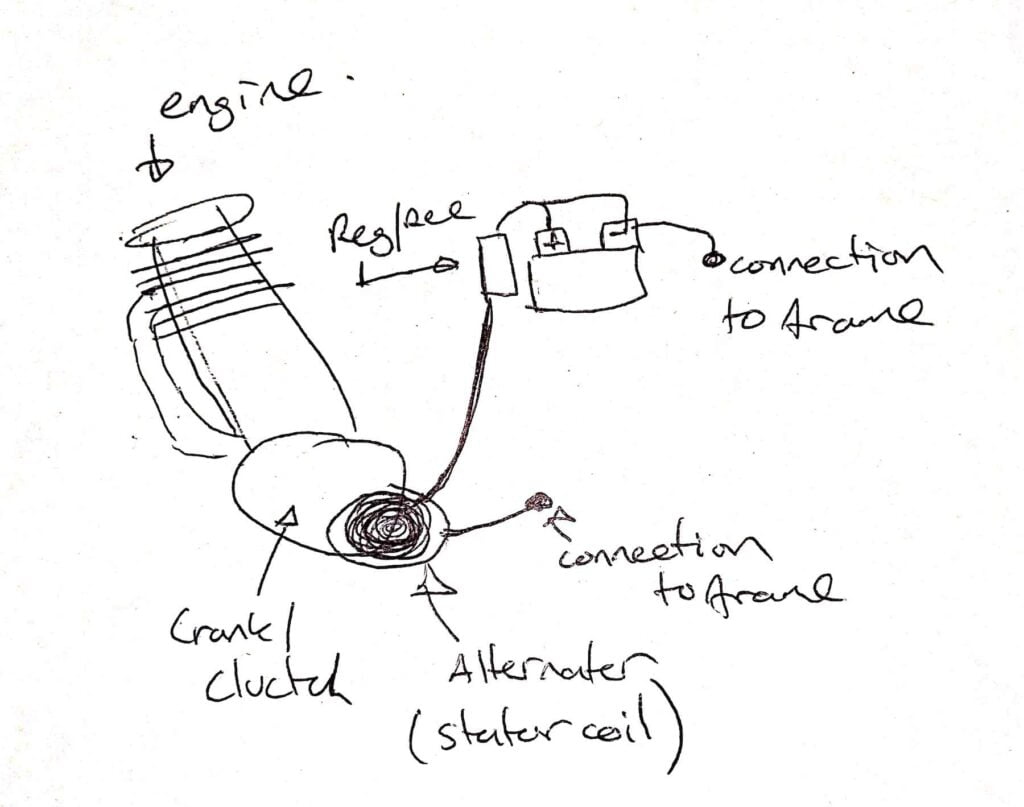
Luckily, the charging system of nearly every motorcycle is the same. There’s really very little that changes.
The major things I’ve seen change on modern motorcycles is that sometimes the stator coil isn’t driven directly off the engine, and is instead in a different unit (the alternator) driven by a belt, just like in a car. I’ve seen this most recently in BMW R1200* engines, and I wrote up a guide to changing the alternator belt here too.
Symptoms of a bad motorcycle charging system
There are a number of major symptoms of a bad motorcycle charging system. Any one of these can mean something in your charging system is broken.
- Motorcycle won’t start. This one’s the big, obvious one. When it turns over super slowly or you just hear a “click” noise, then something in the motorcycle charging system is kaput.
- Spluttering as you drive. When voltage is low, it’s hard to keep the motorcycle running.
- Lights light up and dim as you rev. This shouldn’t happen — your motorcycle should keep the lights constant (unless it’s a truly ancient motorcycle).
- Battery warning light comes on. Oh, so you have a fancy, late-model motorcycle do you? Actually battery lights are pretty common — my 14-year-old 2006 BMW R1200S has one (which came on).
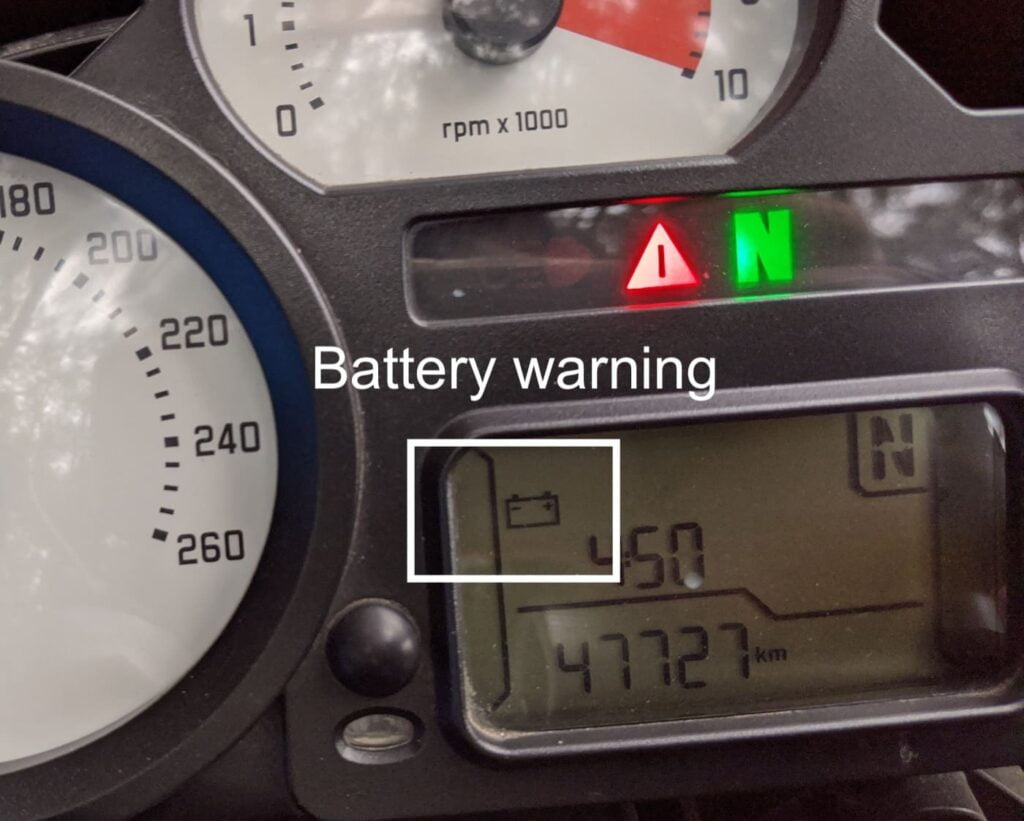
There are other symptoms too, but those are the main ones.
What can go wrong with the charging system?
Basically, when your motorcycle isn’t charging (or it turns off), it means one of the components above has failed!
Failures of a component in the motorcycle charging system happen in a number of different, all fairly common ways:
- Regulator/rectifier overheats and dies. The Reg/rec lives a long and difficult life. The whole time the motorcycle is on it’s sucking in current from the alternator, trimming it back to the right voltage, and converting it to DC so your battery can charge. What happens to the excess current? It just turns it into heat. That’s why the reg/rec has a huge heatsink on it (it gets hot) and sits in airflow. All this gets too much after a while, and after about 50,000 km (or about 1,000 hours of operation) it’s pretty reasonable for them to die.
- Battery gets old. Batteries have a shelf life. Once they get old, or if they’re not properly maintained, they die. Modern batteries do last longer.
- Battery gets fried by other components. If your reg/rec isn’t regulating voltage properly it might be sending too much voltage into the motorcycle’s battery. Motorcycle batteries operate between about 12 and 14.5V — any more than this puts a lot of stress on them. A fried reg/rec means you might see voltages of over 20V when revving high which is bad news for the battery.
- Stator coil has died. Or if you have a separate alternator, your alternator might have died — or the belt might have broken (j’accuse, BMW!)
- Loose wires. Lots of times, people don’t realise that they can’t just use a screwdriver to screw down the battery terminal wires. You have to use a wrench and give it at least 5 Nm of torque (i.e. hand-tight).
Equipment you need for testing a motorcycle charging system
You need a bit of equipment. People are often shy the multimeter, to start with.
- A multimeter. Any household one will do. But I like this good quality (but affordable) Fluke automotive multimeter. This is a combination of a voltage meter, a resistance meter, and continuity tester (all things you need).
- A battery charger. Your motorcycle has to be fully charged before you can do the tests. You can use a Battery Tender (that 0.75A “Junior” one will charge a motorcycle battery overnight), and also use it to maintain your battery.
Besides that, all you need are regular tools, like the ones in your toolkit. You’re going to need to get at the battery and to unplug a few things. I’d just say you need
- Needle-nose pliers to undo a few clips
- Allen keys to undo (and re-do) bolts and stuff
- Working gloves (optional) because my hands always get filthy when I do this stuff!
Before doing any tests on your motorcycle charging system… you need to use that trickle charger you bought from Amazon or eBay. Leave it on overnight.
You have to charge your battery before you do any other tests, or your results may not be meaningful.
To charge your battery you usually have to remove the seat, and the fairings if you have them. Sometimes you have to remove the tank — I pray this isn’t you!
Mental note: I’m so thankful I have a motorcycle that has a fairing (to keep me warm) but that it’s a bikini fairing so I can access everything.
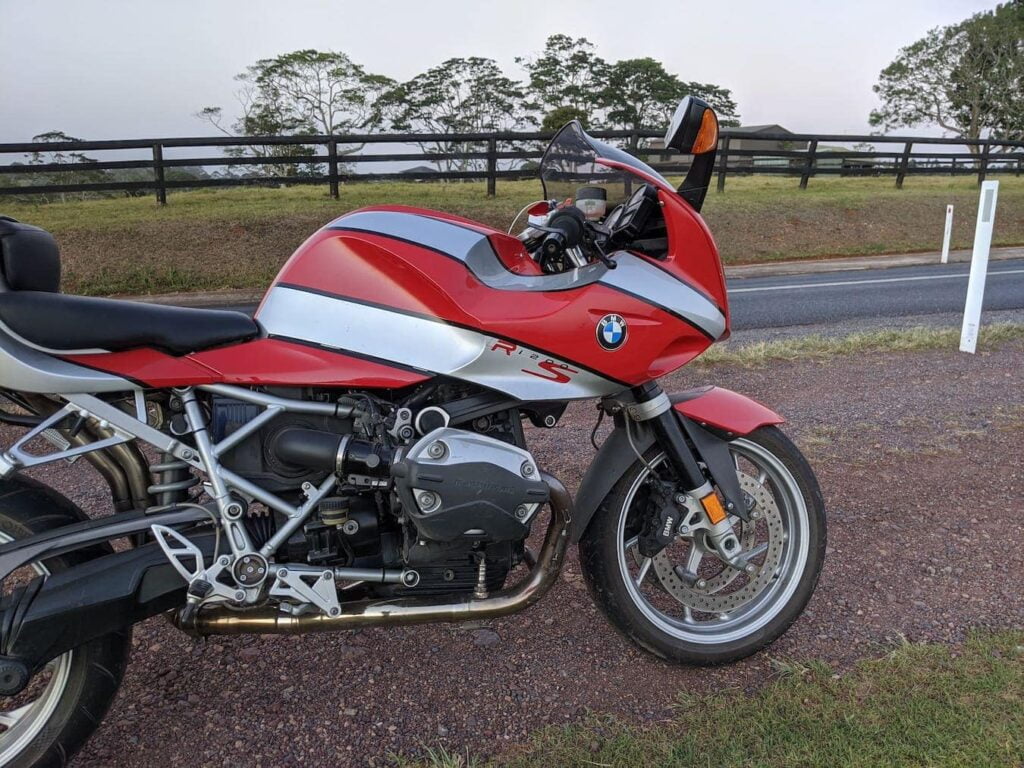
Test 1: Battery voltage a with motorcycle off and then on

If you are using a charger, the light will indicate the battery is charged (hopefully).
Once your battery is charged, you’re now ready to start testing your motorcycle charging system! Test the voltage of the battery using your multimeter.
- If your voltage is at or above 12.4V — you’re good.
- If your voltage is below 12.4V after a charge — you need a new battery.
Before you buy a new battery — if your motorcycle was acting normally and suddenly you need a new battery… you have to ask yourself: “Why is my battery dead?”
If it’s just old — like, the battery has literally never been changed, or it’s more than 5 years old — then you might feel comfortable changing the battery.
But if a bad regulator/rectifier has fried it, then you will just fry a new one again, wasting time and money. Test the reg/rec — we’ll do that next.
Now do a similar set of tests — with the motorbike on.
Disconnect your multimeter for a sec (so voltage spikes don’t nuke it).
Now turn the motorcycle on, let it warm up for a bit, and check the voltage at the battery again.
- At idle, the voltage should be around 12-13V.
- At 3,000rpm, the voltage should be no more than 15V.
Is the voltage less than 12V at idle? Then something isn’t producing enough current. You might have a short somewhere in the system drawing too much current, you might have a faulty alternator/stator coil, or your reg/rec may have totally failed.
Is the voltage more than 15V at 3,000 rpm? If so, then your regulator/rectifier might be partially fried. You can do some more tests on it (that’s a story for another day). But you can either take it in, or take a pot-shot and buy one and replace it. Worst case, you’re going to need that spare later (they all die eventually).
To dive deeper into what part of your motorcycle charging system isn’t working, look at whether your alternator/stator coil are working, or if your reg/rec is functioning as intended.
Test 2: Alternator/Stator coil
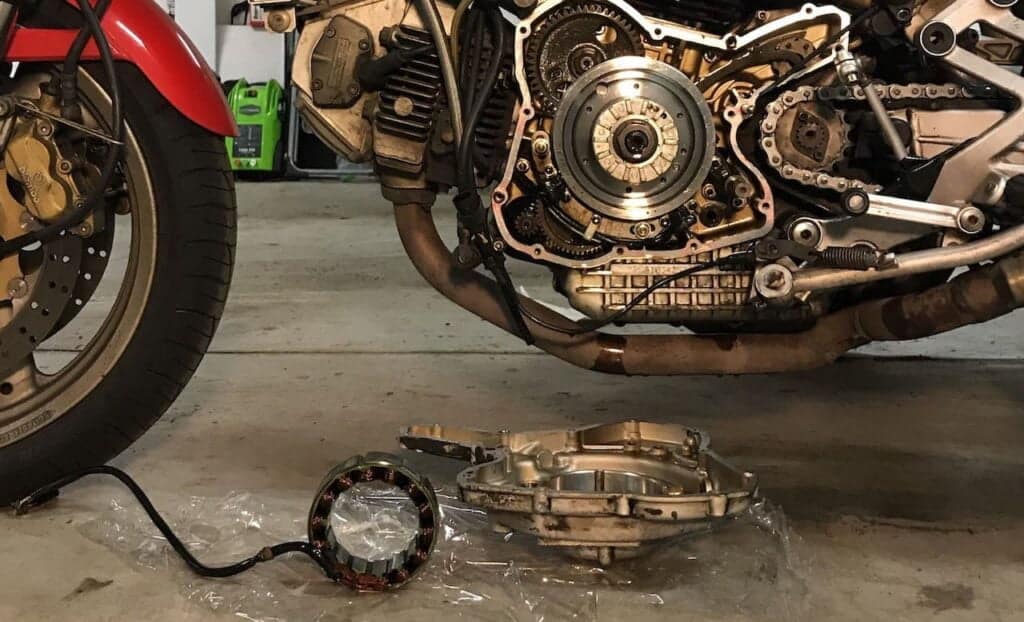
You need to figure out if your alternator/stator coil is producing enough power. You can usually see if it is by testing the output voltage.
The stator coil is a coil (or a series of coils) that sits around the rotor. The rotor is just a magnet connected to the crankshaft of the motorcycle.
When the motorcycle’s engine is turning — i.e. when it’s on (or if you push start it!) — the rotor magnets turn. The magnets turn inside the coils of the stator. The changing magnetic field caused by the turning magnets induces current in the coils. It works the opposite way an electric motor does.
To test your stator coil, you need to test if it’s producing enough voltage. If it is, it’s usually a sign it can carry the load. (Not necessarily, but almost always.)
First, find the output of your stator coil. There’s usually a plug coming out of the whole area.
Don’t know where the output of the stator coil is? On longitudinally mounted engines, like V-twins, you can usually find the clutch on one side of the engine and the stator on the other side. You know the clutch side because the clutch cable and actuator goes to it. You know the stator side because it’s the other side! On that side, you might find the plug.
On transversely mounted engines, like my BMW or many inline-four motorcycles, it’s not so obvious. There, it’s easier to find the regulator/rectifier (under the seat, quite often) and check the voltage there.
Once you’ve found the output of the stator coil, do the following tests:
Tests on the alternator/stator coil with the engine off:
- Check the resistance between each of the pins (if there are just two, then the resistance between the two). Use your multimeter on a low resistance scale. The resistance should be low (0.2-0.5 ohms roughly). If it’s open circuit: that coil has opened up. If it’s a short circuit: bad news, both coils are shorted to ground.
- Check the resistance between the pins and earth (the chassis, or the negative terminal of the battery). This should be open circuit. If it’s anything but, then there’s a malfunction.
If you still haven’t found any problems, you can do some tests with the engine on. You’ve charged the battery, so it should start up.
Tests on the alternator/stator coil with the engine on:
Put your multimeter in AC mode.
You now can test the voltage between the terminals of the stator coil at 3,000 rpm. Depending on your motorcycle, you should get a reading of anywhere between 20 and 50 volts.
What voltage you get isn’t important (unless it’s less than 15 — at 3,000 rpm, you should definitely have enough voltage to charge the battery, i.e. more than 15). The more important thing is that a) there is a voltage reading on all terminals and b) they’re all pretty similar (if you have a multi-phase alternator).
Some older alternators are just two-phase and have only two output wires. With those, that’s the only voltage you measure.
Most modern alternators have three phases and have three output wires. So you have to measure A-B, B-C, and A-C. In this case, your voltages have to be similar.
Test 3: Regulator/Rectifier
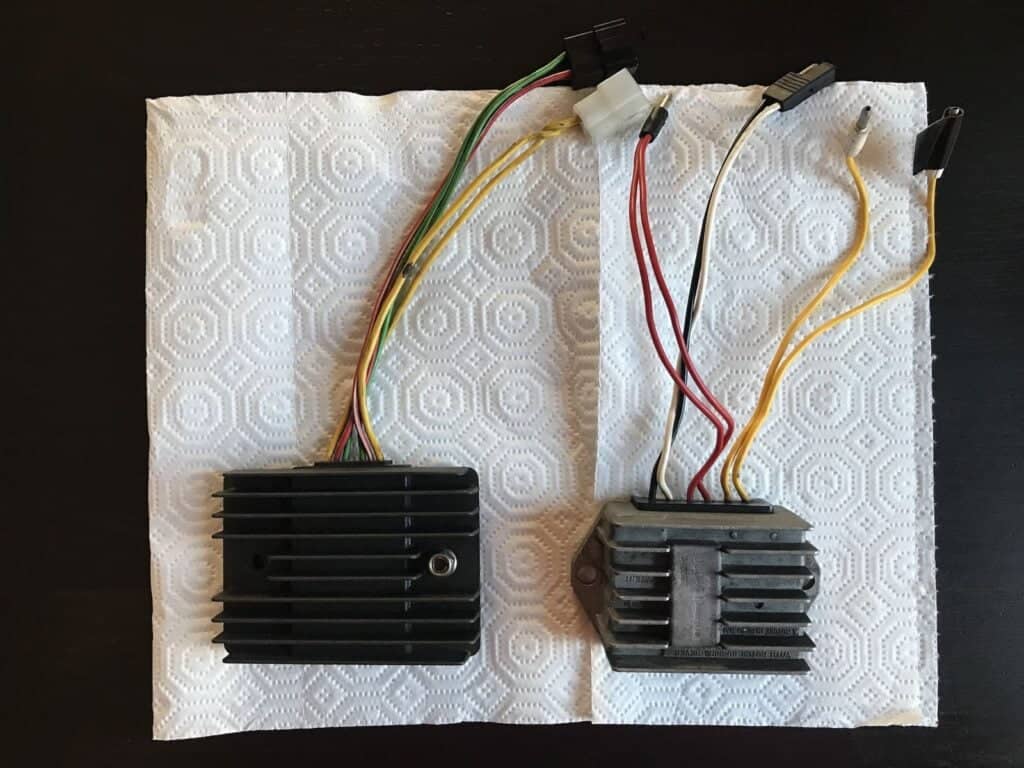
The final test is of your regulator/rectifier.
These fail often on older motorcycles because they live a very hard life. For millions of engine revolutions, they have to get a big voltage, invert it to DC, then trim off the excess, bleeding it to heat.
This is what regulator/rectifiers do (they’re actually two things, but they’re usually in the one unit because they’re easy to build that way — they’re made out of high current diodes).
The rectifier converts AC voltage to DC. This is the same as in any power adaptor in your house, like for your phone charger. The AC voltage that comes out of the wall socket needs to be converted to DC to charge your devices. AC can only be used for things that just provided heat or light (where the direction of current doesn’t matter), like ovens, toaster, kettles, and lamps.
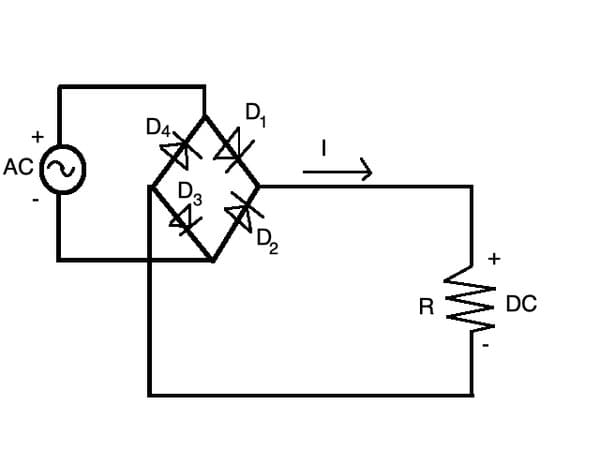
The regulator brings the voltage down from high levels to levels where it won’t fry your battery. The alternator produces massive voltages — higher as your engine spins higher. The regulator trims off the excess and only gives your battery what it needs. Sometimes, this is trimming off over 70% of the available voltage!
The sad part about that is that it just discards that excess power as heat. That’s why regulators fry. They get overwhelmed.
Sidebar: I’ve seen it suggested by mechanically knowledgeable people that disconnecting power-drawing things (like lights) can overload a regulator rectifier as the power has nowhere to go. This isn’t how power circuits work. The regulator doesn’t regulate any power not drawn from the alternator.
Otherwise, as a parallel, our laptop’s power supply would overload when the laptop isn’t plugged in. Or batteries would overheat when not plugged in.
So don’t worry about unplugging accessories — regulators overload from too much power been drawn through them, and/or poor ventilation. Focus on good ventilation and not overloading them and you’ll be right.
When a regulator fries, you either get a) no voltage (flat battery) or b) excessive voltage (fried battery, which also means flat battery).
That’s why if you have a dead battery and you replace it without checking your reg/rec, you may just fry the battery again.
To test the regulator/rectifier: Well, if you understand how diodes work, you can set your multimeter to “diode” mode to test the polarity of the terminals of your reg/rec module. The configuration of diodes and the orientation of the bridge depend on your specific motorcycle, so you need to consult the wiring diagram of your motorcycle manual.
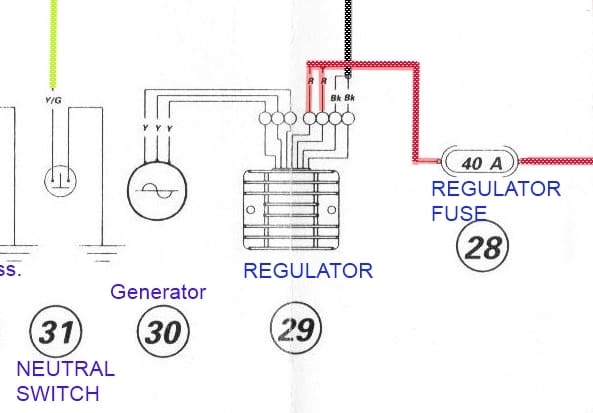
If that was gibberish, then here’s a good testing algorithm: If your stator coil was producing the right voltages in the tests above, but the voltages at your battery seem off (e.g. when revving it goes above 15V), then your reg/rec module is dead.
If your reg/rec module is dead, you can buy the same part — or, if you’re game, you can buy a similar part from any other motorcycle, cut the wires, and splice it in.

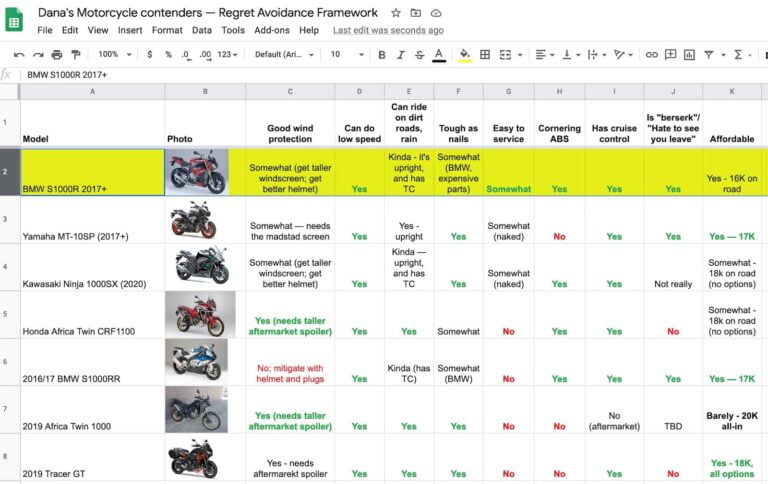


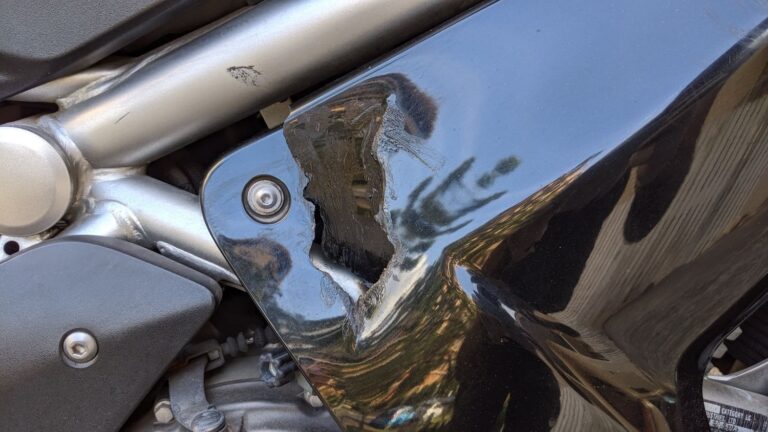
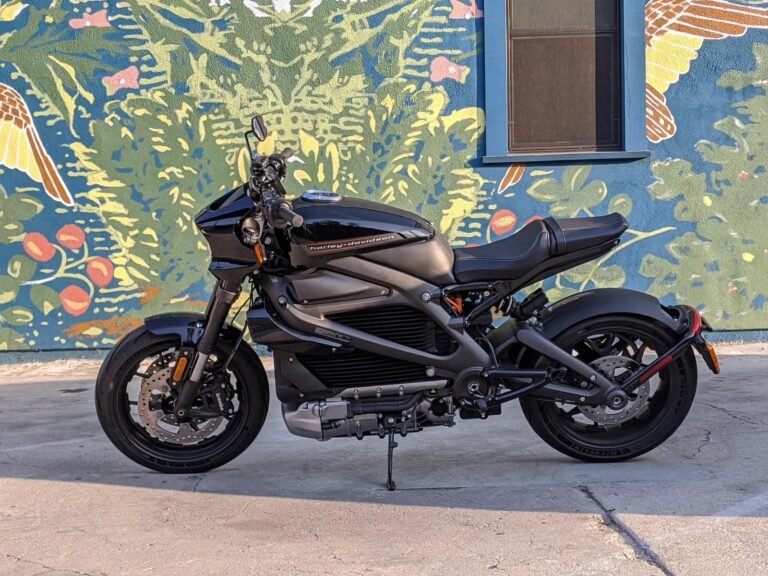
Good stuff. Thx!
Thank you for this , it’s great for an electrical newbie ! Gives me direction and good place to start ! Best wishes !
Hello, i have a 2005 vstar 650 classic. 25,000 miles.
I am having battery issues i can charge the battery fully, ride a small distance then the bike first cuts out like all the electric was shut off for just a second , then bike goes back to running normal then all is fine for about 200ft then the bike just dies. I go to start it. My battery is dead.
SO….I have replaced the stator and pickup coil, i have replaced the battery with a new battery, purchased a new reg/rec from.ebay 26.00 but switched back to oem original rectifier that was originally on the bike.new plugs. Multimeter says battery is high12 low 13 volts after charging…but i need to find out what is making my battery do. This. Also. After the motorcycle dies ( and left me along side the road yesterday) hauled it home, put on charger for 5 to 10 minutes and bike started right up no pblm.
I have NOT replaced the coils under the tank, i have Not replaced the starter, ( in case it has an alternator built in) and i have NOT replaced the CDI box behind the battery. Can someone help me diagnose this and figure out my problem please? (personal info hidden)
Did you found the problem? I have similarish symptoms. Thank you!
Absolutely top form. Thank you dude
Will my bike battery charge if i on my engine and simply accelerate it in neutral on standing position not rotating bike’s tyre
Yes, it will charge like that.
Long time motorcyclist .. 40 odd years.. recently retired..
looking to improve my knowledge on the “dark art “ of automotive electrics
.. charging and ignition systems…
Top drawer info .. very informative and not too complicated…
Regards
Hi. I have a 1980 honda cd200 with a 6 volt system The alternator produces op to 20 volts a/c. Due to problems with the battery overcharging I bought a new voltage regulater/rectifier and battery. All seemed ok, but to reduce the charge at the battery when revving from up to 10 volts to 7 ish I ride with the lights on. After about 5 miles in cold weather the 30 amp fuse melted, (slowly I think as the plastic cover was partially melted. Any ideas of how I can reduce the current to the battery please?
Hi there.. any idea why I would have 8-9 volts at idle from the red wire (to positive) which goes upwards of 50v when reved, only when disconnectedfrom the main positive. but will only show battery voltage 12.6v when connected to the main positive regardless of revs.
Regulator is bad.
Hi there thank u so much for this very helpful information… So my scooter is not giving any voltage at all while it’s idle that mean my regulator is dead
No voltage at all is weird. You’d get some voltage from your battery, even if not enough to start the scooter! Don’t know — only thing I can think of (no judgment, it happens to me too) is you may not be checking voltage against the right parts, or maybe your multimeter is dead or on the wrong setting.
Replaced stator, battery, rectifier and still having pblms. Bike just shuts off and no juice to anything til i put it on charger. 5 to 10 mins later, it starts right up.. could the ignition switch be causing me all my pblms?
Test the ignition switch by shorting the appropriate wires — assuming yours is an older bike where you can do that and it’s not all digital. You may also have a problematic ignition relay. Those are pretty cheap and easy to get (usually standard issue from a car parts store). It got me once! You can also test the ignition relay with a the wiring diagram, a paperclip, and a willingness to accidentally make bad sparks.
Excellent reading! I am having an issue with my 2014 BMW GS F 800 adventure. My Stator/Rectifier plug melted. So I installed a new Rectifier/Stator and the plug got up to 263 F and almost melted. So check and remove both earth ground. Bought a new digital voltage meter and started checking forward and reverse bias, the new Stator is good. But the Diode reading between the new and old rectifier are off. Old .465 .463 .465 new .200 .200 .200 what does this mean??? Thanks Joe
Excellent Article, agree 100% with all that is written!
I’ve just one thing to add:
I understand that the very latest combined Reg/rect units work more efficiently than the conventional type that, as explained, get rid of the surplus unwanted power by converting it to heat. Thus allowing the stator to generate flat out all the time.
I believe the latest ones are of the Mosfet Type and regulate on the AC side by high speed switching, this only allowing whatever power is needed at the time to be generated, they run cooler and reduces the engine power needed to generate as it only generates what’s required and doesn’t run flat out all the time as the conventional ones do.
When the motorcycles’ battery is fully charged and at tickover the bikes headlight is switched on, you’ll often hear the tickover speed drop, this proves the improved method of regulation, but this may not show up on some modern bikes as the engine management system will compensate by keeping the tickover speed constant.
Regards Colin
Thanks for your explanation on the possible faults in the charging system. Very helpful
Your welcome, I obviously don’t know everything, know one doe’s, but I’ve had mega experience over the years. I must say the Author of this site is a very experienced Gentleman to say the least. Shortly, when I’ve the time I’ll post a motorcycle charging problem I solved many years ago now, this charging fault turned out to be the motorcycles’ CDI Unit/Electronic Ignition Unit or whatever it’s officially called these days? Yet the charging system & electronic ignition system are not linked, everybody knows that this is why 4 motorcycle dealers at the time could not diagnose the fault, I must admit, it took me three weeks on & off to find it! It will be interesting reading when I explain, that’s if the modulator will allow me to post the cause?
Colin
I have a problem with my 1965 Triumph TR6 motorcycle. It has a new battery, I checked the voltage and it read 12.45volts
I road about 30 minutes, and checked the battery the next morning and it read 12.22volts, road another 30 minutes, and the next day it read 11.72 volts.
It has a single phase stator, and a Boyer Power Box in please of the original rectifier. Both the stator, and the Boyer power box were installed about 1998 but actually don’t have many miles on them. The bike sat from 2008 till about two weeks ago, and before that I just took leisure rides of maybe an hour at a time.
Other than losing a little voltage each ride the bike runs perfect..
Thanks for any help
My Pulsar RS200’s stator is heating up very much, the engine is on the clutch side is not heating that much but stator’s side is heating, I have noticed that the connector from the stator coil are burning, two years ago I had the same problem so I have replaced all 3, the battery, regulator/rectifier, stator unit. and now the problem came again, I have tested the stator wires with multimeter they all 3 wires are producing same amount of current of 20-23 in idle rpm of 1500, and when I tested the coil wire +ground the multimeter is showing 11-13 volts, what it might be? I have opened the stator cover and it got fried the three wires, any wire isn’t touching to ground, can you please address this issue…
The battery on my bike before I start it sits at around ~13.1v. When I start my bike, the voltage drops to around 12.6 volts at idle, but when I rev it, it drops even more anywhere between 11.4v to 12.3v. Does anyone know whats wrong here? I have reason to believe it is my reg/rec but want to go spending money until I properly know.
Kieran
My ’82 Honda CB900 Custom seems to not be charging. After a “tender” charge, voltage is 12.8 or 12.7, not running. Starts fine but voltage drops to 11.2/11.3 at idle. Rev to 3000 rpms, voltage 11.6. Take a short drive (8 miles), horn is low and signals are slow. Run it home and recharge. Ugh. Does the magnets in my rotor lose polarity. Nothing steel sticks to them. Bike sits all winter and is in great shape. Any clues?
All really great info!! Well done and thank you! *Curious, do you record yourself performing these on YouTube in the detail that you write or is this your main media? Thanks again!
I’m experiencing a problem with my motorcycle. The AC output is functioning properly, but when I connect the regulator, the voltage output drops to 4-5 volts. Could this be due to a short circuit or some other issue?
Sorry I know this posting old but I just found it, I’ve tested everything with fully charged battery, all seems ok. Except rectifier only putting out 12.6 v at 4000 rpm. I see lots of Info on higher than 15 but not much on under 13v. Can anything tell me what I may be working with here? Or is the R/R gone?